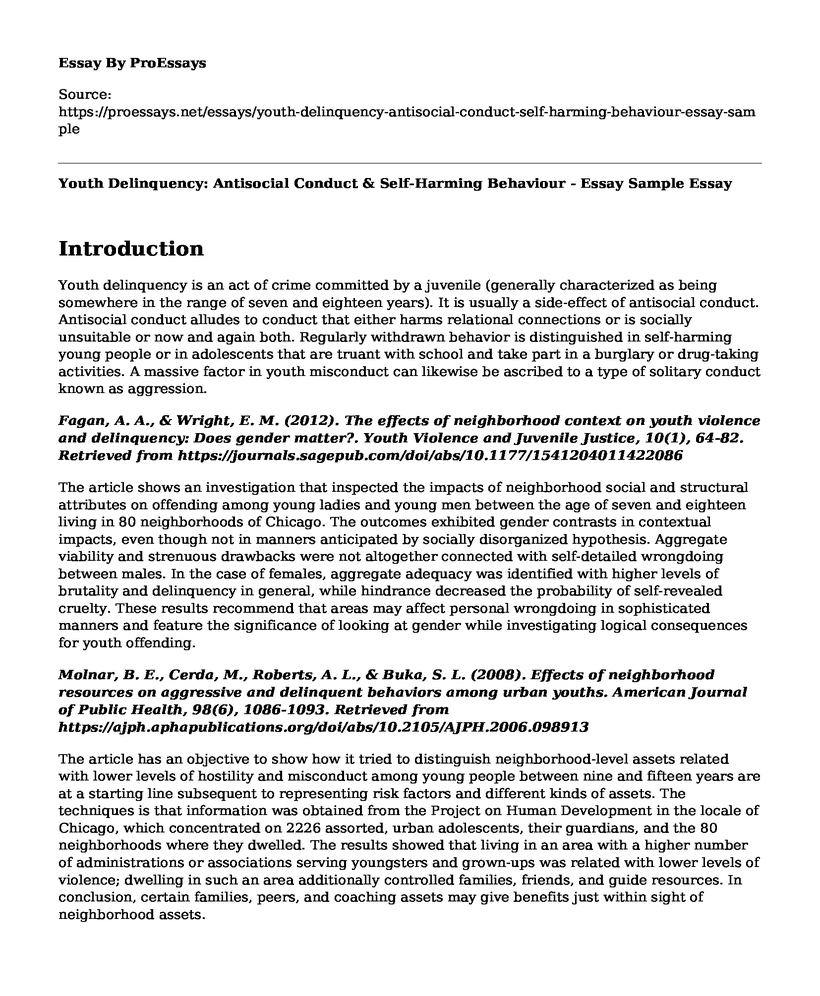Introduction
Youth delinquency is an act of crime committed by a juvenile (generally characterized as being somewhere in the range of seven and eighteen years). It is usually a side-effect of antisocial conduct. Antisocial conduct alludes to conduct that either harms relational connections or is socially unsuitable or now and again both. Regularly withdrawn behavior is distinguished in self-harming young people or in adolescents that are truant with school and take part in a burglary or drug-taking activities. A massive factor in youth misconduct can likewise be ascribed to a type of solitary conduct known as aggression.
Fagan, A. A., & Wright, E. M. (2012). The effects of neighborhood context on youth violence and delinquency: Does gender matter?. Youth Violence and Juvenile Justice, 10(1), 64-82. Retrieved from https://journals.sagepub.com/doi/abs/10.1177/1541204011422086
The article shows an investigation that inspected the impacts of neighborhood social and structural attributes on offending among young ladies and young men between the age of seven and eighteen living in 80 neighborhoods of Chicago. The outcomes exhibited gender contrasts in contextual impacts, even though not in manners anticipated by socially disorganized hypothesis. Aggregate viability and strenuous drawbacks were not altogether connected with self-detailed wrongdoing between males. In the case of females, aggregate adequacy was identified with higher levels of brutality and delinquency in general, while hindrance decreased the probability of self-revealed cruelty. These results recommend that areas may affect personal wrongdoing in sophisticated manners and feature the significance of looking at gender while investigating logical consequences for youth offending.
Molnar, B. E., Cerda, M., Roberts, A. L., & Buka, S. L. (2008). Effects of neighborhood resources on aggressive and delinquent behaviors among urban youths. American Journal of Public Health, 98(6), 1086-1093. Retrieved from https://ajph.aphapublications.org/doi/abs/10.2105/AJPH.2006.098913
The article has an objective to show how it tried to distinguish neighborhood-level assets related with lower levels of hostility and misconduct among young people between nine and fifteen years are at a starting line subsequent to representing risk factors and different kinds of assets. The techniques is that information was obtained from the Project on Human Development in the locale of Chicago, which concentrated on 2226 assorted, urban adolescents, their guardians, and the 80 neighborhoods where they dwelled. The results showed that living in an area with a higher number of administrations or associations serving youngsters and grown-ups was related with lower levels of violence; dwelling in such an area additionally controlled families, friends, and guide resources. In conclusion, certain families, peers, and coaching assets may give benefits just within sight of neighborhood assets.
Jain, S., Buka, S. L., Subramanian, S. V., & Molnar, B. E. (2010). Neighborhood predictors of dating violence victimization and perpetration in young adulthood: A multilevel study. American journal of public health, 100(9), 1737-1744. Retrieved from https://ajph.aphapublications.org/doi/abs/10.2105/AJPH.2009.169730
The article targets to analyze whether standard procedures of neighborhoods, for example, efficacy, during a person's teenage years influence the probability of being associated with physical dating brutality during young age. The article utilizes longitudinal information on 633 urban young people between thirteen and nineteen years at the baseline and information from their surroundings. They ran staggered straight relapse models independently by sexual orientation to survey the relationship between aggregate adequacy and physical dating violence exploitation and execution, controlling for personal covariates, poverty in the neighborhood, and abuse observed in the district. The results were that females were mainly almost certain than the male to be culprits of dating brutality during young age. It concluded by saying the community level procedures might be valuable in forestalling dating brutality.
Haynie, D. L., Silver, E., & Teasdale, B. (2006). Neighborhood characteristics, peer networks, and adolescent violence. Journal of Quantitative Criminology, 22(2), 147-169. Retrieved from https://link.springer.com/article/10.1007/s10940-006-9006-y
The article suggests that, although environmental analysts reliably discover high levels of violence and crime inside financially disadvantaged neighborhoods, there is less accord concerning why this example exists. To address this issue, the article uses information from the National Longitudinal Study of Adolescent Health to analyze three research questions that are related. Are surrounding attributes related to pre-adult violence net of determination and compositional impacts? Are neighborhood qualities related with young people's introduction to prosocial peers and violence? Does the introduction to peer intervene the descriptive attributes that are violence affiliation? Results demonstrate that over a broad scope of neighborhood, the financial detriment is entirely identified with pre-adult brutality net of compositional and determination impacts.
References
Fagan, A. A., & Wright, E. M. (2012). The effects of neighborhood context on youth violence and delinquency: Does gender matter?. Youth Violence and Juvenile Justice, 10(1), 64-82. Retrieved from https://journals.sagepub.com/doi/abs/10.1177/1541204011422086
Haynie, D. L., Silver, E., & Teasdale, B. (2006). Neighborhood characteristics, peer networks, and adolescent violence. Journal of Quantitative Criminology, 22(2), 147-169. Retrieved from https://link.springer.com/article/10.1007/s10940-006-9006-y
Jain, S., Buka, S. L., Subramanian, S. V., & Molnar, B. E. (2010). Neighborhood predictors of dating violence victimization and perpetration in young adulthood: A multilevel study. American journal of public health, 100(9), 1737-1744. Retrieved from https://ajph.aphapublications.org/doi/abs/10.2105/AJPH.2009.169730
Molnar, B. E., Cerda, M., Roberts, A. L., & Buka, S. L. (2008). Effects of neighborhood resources on aggressive and delinquent behaviors among urban youths. American Journal of Public Health, 98(6), 1086-1093. Retrieved from https://ajph.aphapublications.org/doi/abs/10.2105/AJPH.2006.098913
Cite this page
Youth Delinquency: Antisocial Conduct & Self-Harming Behaviour - Essay Sample. (2023, Jun 19). Retrieved from https://proessays.net/essays/youth-delinquency-antisocial-conduct-self-harming-behaviour-essay-sample
If you are the original author of this essay and no longer wish to have it published on the ProEssays website, please click below to request its removal:
- Nonprofit Hospital Dealing With the Affordable Act Care
- Essay Sample on Disparities Among the Minority and Criminal Justice
- Essay Sample on Robbery vs Extortion: Know the Difference
- Essay on Problem-solving & Crime Prevention: Community Policing for Creative Solutions
- The Pursuit of Freedom: The History of Racism in America - Essay Sample
- Black Lives Matter Social Movement - Free Essay Sample
- Justifying the British Troop's Actions During the Boston Massacre: A foundation of History - Paper Sample







